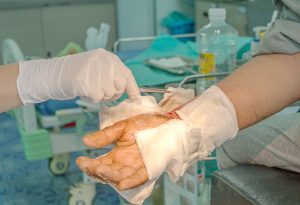Burn Injuries and Skin Grafts
 Second- and third-degree burn injuries often leave serious scars and disfigurement. Severe burns can also cause functional damage and a great deal of pain. Surgical treatments may require breathing assistance, the use of a feeding tube, addressing blood flow problems, skin grafts, and plastic surgery. Other treatments – including physical therapy and psychological counseling – may also be required.
Second- and third-degree burn injuries often leave serious scars and disfigurement. Severe burns can also cause functional damage and a great deal of pain. Surgical treatments may require breathing assistance, the use of a feeding tube, addressing blood flow problems, skin grafts, and plastic surgery. Other treatments – including physical therapy and psychological counseling – may also be required.
What are skin grafts?
The Burn Injury Guide states that in a skin graft, healthy skin is taken from another part of the burn injury victims’ body and attached to the site of the burn. A skin graft operation may be required when the injury is severe enough that a victim might die without the skin graft, or the victim might suffer permanent skin damage. The procedure helps reduce the need for other treatments and improves the appearance and functionality of the burn injury site.
The part of the body where the skin is taken from is known as the donor site. Typically, the donor site is a nonvisible site of the victims’ body, such as the inner thigh or the buttocks.
How does the skin graft procedure work?
Skin grafts are done under general anesthesia. The skin from the donor site is transplanted to the burn site. A skin graft is normally held in place by using small stitches, staples, or well-padded dressings. The donor site is normally covered with a sterile site for several days.
What are the different types of skin grafts?
There are three basic types of skin grafts. The type that is used depends on the severity and size of the burn, including:
- Split-thickness skin grafts. This is the most common type of skin graft for a burn injury. The graft uses the top two layers of skin from the donor site. A split-thickness skin graft operation is similar to peeling a potato, as it involves the most outer layers of the skin.
- Full-thickness skin grafts. This procedure involves transplanting the epidermis and all of the underlying dermis. The procedure is more complicated than a split-thickness skin graft. Common donor sites include the walls of the abdomen or chest, and the back.
- Composite skin grafts. According to Zwivel, a skincare company, in a composite graft, “the harvested skin includes underlying cartilage.” For example, a burn injury victims’ nose burns might be transplanted with a composite graft from their ear.
Grafts are frequently categorized according to where the donor skin comes from. There are several terms used to describe donor skin sources:
- The skin comes from another part of your own body. These grafts have a higher success rate because they’re a genetic match.
- Allogenic graft. Here, another person donates their skin.
- The donor skin is another species, such as a pig. Zwivel notes that these types of skin grafts are always temporary.
- Prosthetic graft. The donor skin is synthetic.
- Laboratory grown. The skin comes from skin cells of the patient or a donor that are grown in a laboratory.
What are the possible complications of a skin graft?
There are certain dangers with skin graft procedures, including:
- Scarring in the transplanted tissue
- Complete or decreased loss of sensation in the transplanted skin area
- Conditions such as discolored skin and uneven skin surfaces
- Skin may not heal properly, which may require additional skin graft surgeries
Other risks involved with skin graft procedures include:
- Bleeding
- Infection
- Nerve damage
- Loss of the grafted skin
- Chronic pain
How can Harris Lowry Manton LLP help with your burn injury claim?
The personal injury lawyers at Harris Lowry Manton LLP understand the trauma of burn injuries. Burns can cause unbearable physical and emotional pain. Many victims need extensive physical and psychological therapy in addition to their surgeries and medical care. We fight to hold the people and/or businesses that caused your burn injuries liable.
We demand compensation for all your pain and suffering, your lost income, and property damage. In burn injury cases, we also demand compensation for any scarring or disfigurement – especially if the burns are on a visible part of your body such as your face or neck.
Our burn injury settlements include:
- $21,000,000 for a commercial vehicle fire resulting in multiple burn fatalities
- $3,200,000 for an industrial fire resulting in serious injuries
- $2,500,000 for burn injuries from a commercial vehicle accident
We work with your team of doctors and health care providers to fully verify how extensive and severe your burn injuries are and how much the burns affect your life. To discuss your burn injury case, call our Atlanta office at 404-998-8847, our Savannah office at 912-417-3774, or fill out our contact form to schedule an appointment.

One of the nation’s top trial attorneys, Jeff Harris is an award-winning litigator who handles high-profile, complex cases across a wide variety of practice areas. He excels at securing justice for clients who have been seriously injured or killed, holding responsible parties accountable for their actions as well as their negligence.
Read more about Jeffrey R. Harris here.
